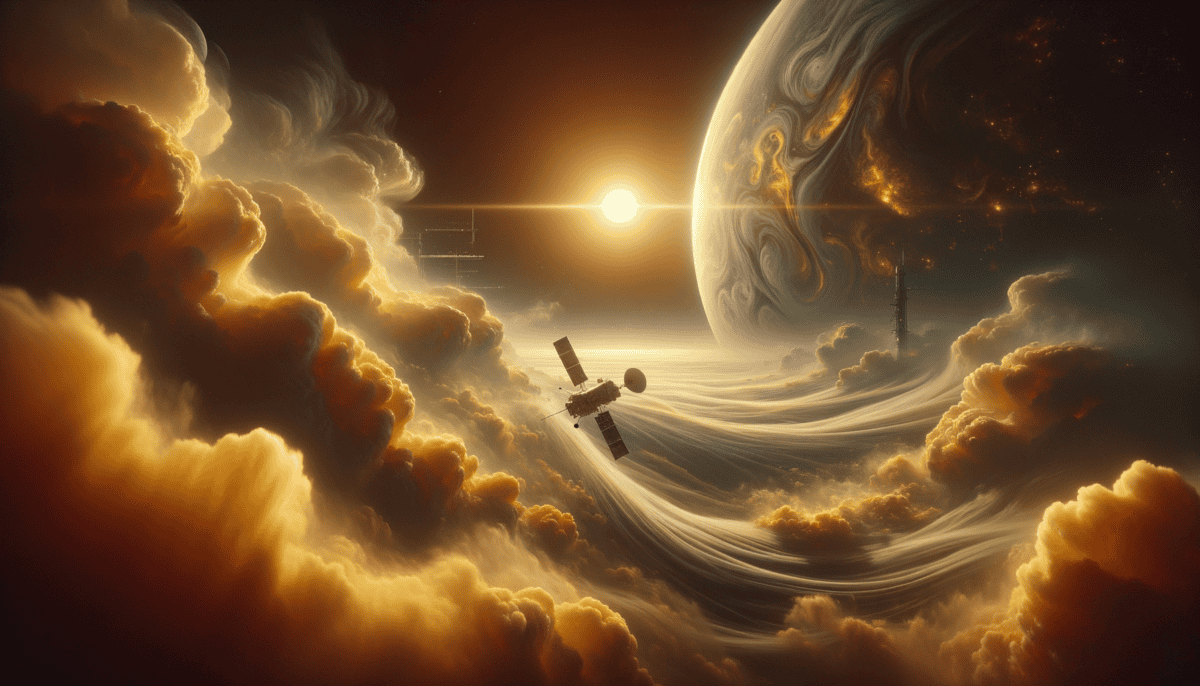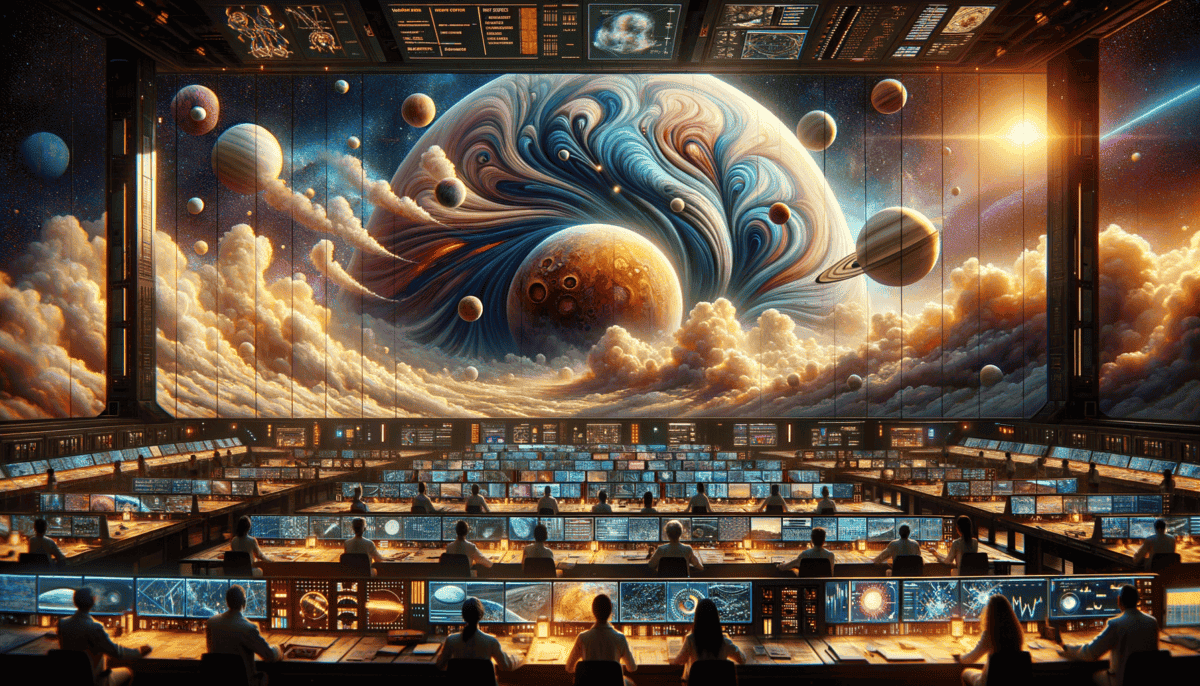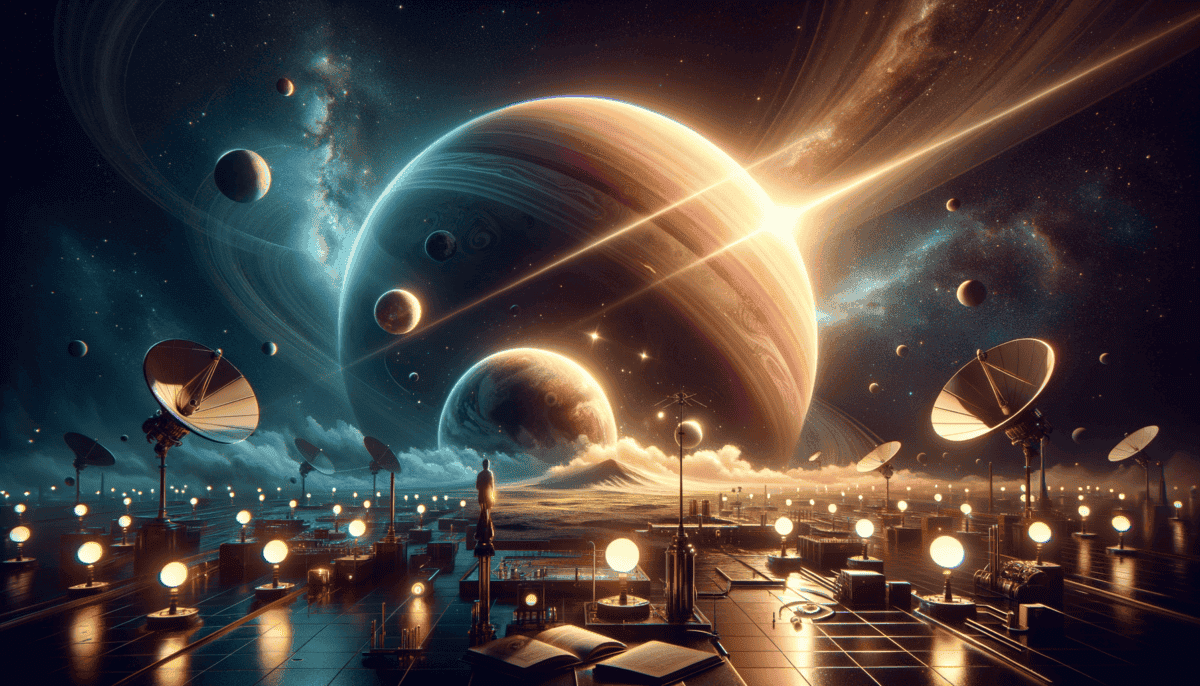The Brightest Star
On a clear night, a bright light twinkled in the sky. Little Sarah pointed up with excitement. “Look, Daddy! Is that a star?”
Her father smiled and shook his head. “That’s Venus! It’s actually a planet, but it shines so bright that many people think it’s a star.”
Did you know? Venus is so bright that it can sometimes cast shadows on Earth at night!
Venus has been watching over us for a very long time. Long ago, people called it both the morning star and the evening star. They didn’t know it was the same planet! They saw it shine brightly in the morning before sunrise and again in the evening after sunset.
Fun Fact: Venus is our closest neighbor planet, kind of like living next door to us in space!
Sarah’s eyes grew wide. “But why is it so bright, Daddy?”
“Well, sweetheart, Venus is covered in thick, white clouds that act like mirrors. These clouds reflect the Sun’s light back to us, making Venus look super bright from Earth.”
Ancient Stories About Venus
People all over the world have told stories about Venus for thousands of years. Here are some of the names they gave it:
- The Romans named it after their goddess of love
- The Greeks called it Phosphorus in the morning
- The Mayans thought it was their war god
Scientists were very curious about what was under those bright clouds. They couldn’t see through them with their telescopes, so Venus kept its secrets hidden for a long time.
“Can we visit Venus?” Sarah asked hopefully.
Her father laughed softly. “Not yet, sweetie. But we have sent special robots called space probes to learn more about it. They’ve helped us discover some amazing things!”
“Venus is like Earth’s mysterious twin sister,” Sarah’s father explained. “It’s almost the same size as our planet, but it’s very different in many other ways.”
Sarah grabbed her telescope and pointed it toward Venus. The bright planet sparkled like a diamond in her viewfinder. She wondered what other secrets this beautiful world might be hiding.
Amazing Venus Facts:
✨ Second planet from the Sun
️ Hotter than an oven
☁️ Covered in thick clouds
Almost as big as Earth
That night, as Sarah drifted off to sleep, she dreamed about the mysteries of Venus. What was hiding under those shimmering clouds? What secrets would we discover next? The bright planet continued to shine in the night sky, keeping its mysteries for another day.
Piercing the Cloudy Veil
“Space Mission Control, this is Venera 7, preparing for descent.” The radio crackled with excitement as humans prepared to land on Venus for the first time. The year was 1970, and we were about to learn amazing new things about our cloudy neighbor.
Getting to Venus wasn’t easy. Many space robots tried and failed before we finally succeeded!
“Why is it so hard to explore Venus?” asked Tommy during his science class.
Ms. Johnson smiled and pulled out a clear glass jar. “Imagine this jar is Venus,” she said. “Now watch what happens when I fill it with cotton balls.”
Soon, the jar was completely hidden behind fluffy white cotton balls. “This is like Venus’s thick clouds. They make it very hard to see what’s underneath!”
Venus has the thickest clouds of any planet in our solar system! They’re made of acid and are so thick that no one can see through them from Earth.
The Brave Space Robots
Scientists built special space robots called probes to visit Venus. Here are some of the bravest ones:
- Mariner 2: First to fly past Venus
- Venera 7: First to land on Venus
- Magellan: Made maps of Venus
Wow Fact: The Venera probes only lasted a few hours on Venus because it was so hot!
“But what did these brave robots find?” Tommy asked excitedly.
Ms. Johnson drew a picture on the board. “They found that Venus is very different from Earth. It’s super hot – hot enough to melt lead! And it has clouds made of acid rain.”
What We Learned About Venus:
️ It’s the hottest planet
☁️ Has poisonous clouds
Very strong winds
️ Lots of volcanoes
The class gasped. “But why is it so hot?” asked Sarah from the back row.
“Venus has something called the greenhouse effect,” Ms. Johnson explained. “It’s like when you get in a car on a sunny day – the heat gets trapped inside and can’t escape. The same thing happens on Venus, but much worse!”
“Each space mission teaches us something new about Venus. It’s like putting together a giant puzzle, piece by piece!”
The students worked together to build their own model of Venus using a balloon and paper mache. They painted it white for the clouds and added texture for the mountains and valleys that the space probes had discovered.
Even today, scientists are building new and better space robots to explore Venus. They want to learn more about this mysterious world that’s so close to Earth but so very different.
As the school day ended, Tommy looked up at the sky. The sun was setting, and there was Venus, shining brightly. Now he knew what amazing discoveries were hiding behind those clouds, and he wondered what other secrets Venus might be keeping.
A World of Fire and Storm
“Did you know we have a twin planet?” Dr. Chen asked, pointing to a glowing model of Venus. “But this twin is nothing like Earth!”
Venus might look pretty from Earth, but up close it’s a world of extreme heat and powerful storms!
Little Maria raised her hand. “Is it true that Venus is super hot?”
“Yes!” Dr. Chen smiled. She pulled out a kitchen thermometer. “If we could put this on Venus, it would break! The temperature there is hot enough to melt lead – that’s hotter than your mom’s oven could ever get!”
A Day in the Life of Venus
Dr. Chen set up a fun experiment. “Let’s pretend we’re visiting Venus. What would we see?”
First, we’d see orange-colored skies and thick clouds that never go away. The ground would be covered in black rocks and red-hot lava! ⛈️
Amazing Venus Facts:
- ️ Hot enough to melt metal toys
- ☁️ Rains acid instead of water
- ️ Has super strong winds
- Lots of active volcanoes
“But why is Venus so different from Earth?” asked Tommy.
Dr. Chen grabbed a blanket. “Imagine Earth wrapped in one blanket. Now imagine Venus wrapped in thousands of blankets! That’s what Venus’s thick atmosphere does – it traps heat like lots of blankets.”
Think About This: A day on Venus is longer than its year! It takes 243 Earth days for Venus to spin around once.
“Would we find any living things on Venus?” Maria wondered.
“The surface is too hot for any life we know about,” Dr. Chen explained. “But scientists are studying the clouds high above Venus. They might have found something interesting up there!”
The class made their own Venus landscapes using clay and red paint. They added tiny volcanoes that leaked “lava” made from baking soda and vinegar.
“Venus teaches us something important – even planets that look similar can be very different underneath!”
The pressure on Venus is so strong, it would feel like being deep in the ocean – but much, much hotter!
“What if Venus was once like Earth?” Tommy asked thoughtfully.
Dr. Chen’s eyes lit up. “That’s a great question! Some scientists think Venus might have had oceans long ago. Understanding what happened to Venus helps us take better care of Earth.”
As the students filed out of class, they couldn’t help but look up at the bright evening star with new eyes. Venus wasn’t just a pretty light in the sky anymore – it was a world of incredible extremes, teaching us important lessons about our own planet.
Mysterious Clues in the Clouds
“Everyone gather around!” Dr. Chen called excitedly, holding up a new image from the space telescope. “Scientists have found something amazing in Venus’s clouds!”
Could there be tiny living things floating high above Venus? Scientists found some interesting clues!
“But I thought nothing could live on Venus,” said Tommy, looking confused.
Dr. Chen smiled. “On the surface, you’re right – it’s way too hot down there. But up in the clouds, it’s different!”
A Special Gas Mystery
“Scientists found a special gas called phosphine in Venus’s clouds,” Dr. Chen explained. “On Earth, this gas usually comes from tiny living things!”
The clouds of Venus might be just the right temperature for some kinds of tiny life – not too hot and not too cold! ️
Cloud Layer Facts:
- ☁️ Much cooler than the surface
- Has tiny drops of acid rain
- ️ Similar temperature to Earth
- Contains mysterious chemicals
Maria raised her hand. “What kind of living things could be up there?”
“If anything is living in Venus’s clouds, it would be super tiny – smaller than we can see!” Dr. Chen held up a microscope. “Like the tiny organisms we saw in pond water last week.”
Fun Fact: The area in Venus’s clouds where scientists found phosphine is about the same temperature as a warm spring day on Earth!
The class did an experiment using balloons to show how gases can float in the air. “Just like these balloons,” Dr. Chen explained, “tiny living things might float in Venus’s clouds!”
“Sometimes the most exciting discoveries come from places we least expect!”
“But how can we know for sure?” Tommy asked.
“That’s why we’re sending new spacecraft to Venus,” Dr. Chen replied. “They’ll help us look closer at these mysterious clouds!”
Scientists are like detectives, looking for clues about possible life on other planets. Every new discovery helps us learn more!
The students started drawing pictures of what they imagined tiny cloud-floating Venus creatures might look like. Some drew microscopic swimming things, others drew floating bubble creatures.
“Remember,” Dr. Chen said, watching them draw, “we don’t know for sure if anything lives in Venus’s clouds. But isn’t it exciting to imagine the possibilities?”
The search for life on Venus reminds us that the universe is full of mysteries waiting to be solved! ⭐
As class ended, the students couldn’t stop talking about the possibilities. Maybe Venus wasn’t just a hot, stormy world after all. Maybe, high above its burning surface, there were amazing discoveries just waiting to be made.
Dreams of Future Missions
“Guess what, class?” Dr. Chen announced with a big smile. “Space scientists are planning new trips to Venus!”
The classroom buzzed with excitement. Pictures of shiny spacecraft covered the walls, showing all the special machines that would visit Earth’s sister planet.
Three new spacecraft will explore Venus in the next few years. They’re called DAVINCI, VERITAS, and EnVision!
Special Space Explorers
“What will these spacecraft do?” Maria asked, pointing at the pictures.
“Each one has a special job,” Dr. Chen explained. “DAVINCI will drop through Venus’s clouds like a brave sky diver! “
“VERITAS will take pictures of Venus’s surface through the clouds, like having super-strong X-ray vision!”
Cool Mission Facts:
- DAVINCI drops through clouds
- ️ VERITAS makes maps
- EnVision looks for changes
- All send pictures back to Earth
“But how do they survive the heat?” Tommy wondered.
“These spacecraft are super tough!” Dr. Chen showed them a model. “They wear special heat shields, like a very strong sunscreen!”
Amazing Fact: The spacecraft need special protection to survive temperatures hot enough to melt lead!
Working Together
“Scientists from many countries are working together,” Dr. Chen said. “It’s like a big space team!”
“Can we help too?” asked Maria.
“Of course! You can follow the missions online and learn about their discoveries. Maybe someday you’ll build spacecraft too!”
Every mission to Venus helps us learn more about our solar system neighbor!
Future Dreams
“Will people ever visit Venus?” Tommy asked.
“Right now, it’s too hot for people to land,” Dr. Chen explained. “But scientists are dreaming up special floating cities that could float high in Venus’s cooler clouds!”
“The more we learn about Venus, the more amazing possibilities we discover!”
The class worked together to build their own model spacecraft using cardboard and aluminum foil. They added pretend cameras and special shields.
Each new mission brings us closer to understanding the mysteries of Venus!
As they finished their models, Dr. Chen smiled at their creativity. “Remember,” she said, “today’s dreams become tomorrow’s discoveries. Maybe one of you will help design the next mission to Venus!”
The bell rang, but the students weren’t ready to leave. They wanted to keep working on their spacecraft models and imagining future adventures to Earth’s mysterious sister planet.
Cosmic Lessons from Our Sister Planet
“Today, class, we’re going to talk about what Venus can teach us!” Dr. Chen drew a big heart on the board. Inside, she wrote ‘Venus Earth’.
Venus helps us understand our own planet better!
A Tale of Two Sisters
“Venus and Earth started out as twins,” Dr. Chen explained, drawing two circles. “But they grew up very differently!”
Maria raised her hand. “Like my twin sister and me? We look alike but like different things!”
“Exactly!” Dr. Chen smiled. “Venus got too hot, while Earth stayed just right.”
“Learning about Venus helps us take better care of Earth. It’s like having a peek into what could happen if Earth gets too warm!”
Special Climate Lessons
Tommy looked worried. “Will Earth get as hot as Venus?”
“No, Tommy,” Dr. Chen reassured. “But Venus reminds us to be careful with our planet. It’s like having a big sister showing us what not to do!” ️
What Venus Teaches Us:
- Keep Earth’s temperature just right
- Take care of our air
- Protect our oceans
- Love our planet
Future Space Explorers
The class gathered around a globe of Venus. “Every time we study Venus, we learn something new!” Dr. Chen said. “Who wants to be a space scientist?”
Hands shot up across the room. “Me! Me!” the children shouted.
The mystery of Venus continues to inspire new generations of scientists! ⭐
A Bright Future
“Let’s make a promise,” Dr. Chen said, holding up a small blue marble. “Let’s promise to take care of Earth, using all we’ve learned from Venus.”
The class joined hands in a circle. “We promise!” they said together.
Venus will always be there, shining in our sky, helping us learn and grow! ✨
As the last bell of the year rang, Dr. Chen watched her students rush to the windows. They pointed excitedly at the bright evening star appearing in the sky.
“Venus isn’t just our sister planet,” she thought. “It’s our teacher in the sky.”
That evening, children across town dragged their parents outside. “Look!” they said, pointing to Venus twinkling above. “That’s our sister planet!”
As long as we keep looking up, wondering, and learning, the story of Venus will never end!
And somewhere out there, beyond Earth’s warm blanket of air, Venus kept spinning, keeping its secrets, waiting for the next generation of explorers to unlock its mysteries.






